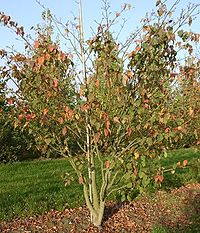Acer capillipes
| Acer capillipes subsp. var. | ||||||||||||||||||||||||||||||||||||||||||||||||||||||||
|---|---|---|---|---|---|---|---|---|---|---|---|---|---|---|---|---|---|---|---|---|---|---|---|---|---|---|---|---|---|---|---|---|---|---|---|---|---|---|---|---|---|---|---|---|---|---|---|---|---|---|---|---|---|---|---|---|

|
|
| ||||||||||||||||||||||||||||||||||||||||||||||||||||||
| ||||||||||||||||||||||||||||||||||||||||||||||||||||||||
Acer capillipes (Kyushu Maple or Red Snakebark Maple), is a maple in the same taxonomic section as other snakebark maples such as A. pensylvanicum, A. davidii and A. rufinerve. It is native to mountainous regions in Japan, on central and southern Honshū (Fukushima Prefecture southwards), Kyūshū and Shikoku islands, usually growing alongside mountain streams.[1][2][3]

It is a small deciduous tree growing to 10–15 m (rarely to 20 m) tall with a trunk up to 70 cm diameter, though usually smaller and often with multiple trunks, and a spreading crown of long, slender branches. The bark is smooth, olive-green with regular narrow vertical white stripes and small horizontal brownish lenticels; it retains its pattern to the base even on old trees. The leaves are 10–15 cm long and 6-12 cm broad, with three or five lobes, the basal lobes of five-lobed leaves being small; they have a serrated margin, conspicuous veining, and a reddish 4–8 cm petiole. They are matt to sub-shiny green in summer, turning to bright yellow, orange or red in the autumn. The flowers are small, greenish-yellow, produced on 8–10 cm racemes in late spring, erect at first but becoming pendulous, with male and female flowers on different racemes. The samara nutlets are 5 mm long, with a 2 cm long wing.[1][2][4][5]
It can be distinguished from the related Acer rufinerve, with which it sometimes grows, by the reddish petioles, the hairless or only thinly hairy leaves (contrasting with the rufous hairs on the underside of A. rufinerve leaves), and in flowering later in spring well after the leaves appear.[1]
It is grown as an ornamental tree for its striped bark and good autumn foliage. When grown together with its close relatives, it may be distinguished from them by the additional presence of small, rust-orange spots on the bark.[4] Hybrids with A. davidii are frequent in cultivation.[5]
- More information about this species can be found on the genus page.
Cultivation
- Do you have cultivation info on this plant? Edit this section!
Propagation
- Do you have propagation info on this plant? Edit this section!
Pests and diseases
- Do you have pest and disease info on this plant? Edit this section!
Cultivars
Gallery
If you have a photo of this plant, please upload it! Plus, there may be other photos available for you to add.
-
photo 1
-
photo 2
-
photo 3
References
External links
- w:Acer capillipes. Some of the material on this page may be from Wikipedia, under the Creative Commons license.
- Acer capillipes QR Code (Size 50, 100, 200, 500)
- ↑ 1.0 1.1 1.2 Kanagawa Prefecture trees and shrubs: Acer capillipes (in Japanese; google translation). Archived 2009-10-24.
- ↑ 2.0 2.1 Flowers of University of Tsukuba: Acer capillipes (in Japanese; google translation)
- ↑ Germplasm Resources Information Network: Acer capillipes
- ↑ 4.0 4.1 van Gelderen, C. J. & van Gelderen, D. M. (1999). Maples for Gardens: A Color Encyclopedia
- ↑ 5.0 5.1 Rushforth, K. (1999). Trees of Britain and Europe. Collins ISBN 0-00-220013-9.
